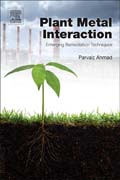
Plant Metal Interaction: Emerging Remediation Techniques covers different heavy metals and their effect on soils and plants, along with the remediation techniques currently available. As cultivable land is declining day-by-day as a result of increased metals in our soil and water, there is an urgent need to remediate these effects. This multi-contributed book is divided into four sections covering the whole of plant metal interactions, including heavy metals, approaches to alleviate heavy metal stress, microbial approaches to remove heavy metals, and phytoremediation. Provides an overview of the effect of different heavy metals on growth, biochemical reactions, and physiology of various plantsServes as a reference guide for available techniques, challenges, and possible solutions in heavy metal remediationCovers sustainable technologies in uptake and removal of heavy metals INDICE: Section: 1. Heavy Metals: Effect and Responses in Plants 1: Heavy metal stress and responses in plants 2:Aluminum toxicity in plants 3:Silicon and biotic stress in agricultural crop Plants: capabilities and limitations 4:Chromium, Environment and Plants: A Dangerous Affair 5:Copper stress and responses in plants 6:Changes in crop productivity of bean plants (Vicia faba L.) in response to copper toxicity and salinity: an overview 7: Behaviour of Copper in Soils. Toxicity, Sorption characteristics and Bioavaibility 8:The effect of lead on plant and human DNA damages and its impact on human life 9:Boron toxicity and its remediation from soil 10:Brassicas and heavy metal stress: An overview 11:Adaptation of higher plants to the heavy metal stress 12:Detoxification of heavy metals and tolerance in plants Section: 2. Approaches to alleviate heavy metal stress 13:Heavy Metal Stress and Molecular Approaches in Plants 14:Effects of heavy metal stress on plants: insights from proteomics 15:Role of phytohormones in alleviating heavy metals stress in crop plants 16:Role of the gene Osmyb in the resistance to low temperatures as well as to Zn and Cu pollution 17:Heavy metal stress signaling in plants Section: 3. Microbial Approaches to remove heavy metals 18:Microbial strategy for the bioremediation of heavy metal contaminated soils 19:Potential of Plants and Microbes for Metal Removal: A Green Clean Approach for remediation of Soil and waste water 20:Land reformation using Plant growth promoting rhizobacteria with context to heavy metal contamination 21: Heavy metal stress tolerance in plants through arbuscular mycorrhiza. Section: 4. Phytoremediation: A Green Clean Technology 22:Duckweed: Hyperaccumulator of heavy metals 23:Plants used in phytoremediation or : Hyperaccumulator plants 24:Transgenic plants in phytoremediation: Recent advances and future possibilities 25:Higher plants suitable for remediation - samples from Central Europe 26:Weed plants and uptake of heavy metals: An overview 27:Phytoremediation of saline soils for sustainable agricultural productivity 28:Phytoextraction, the use of plants to remove heavy metals from soils 29:Phytocheletion and metallothioneins: Role in plants 30:Role of glutathione and phytochelation in heavy metal stress tolerance in plants 31:Selenium: uptake, toxicity, tolerance in plants and phytoremediation 32:Plant metallothioneins: An approach toward heavy metal detoxification 33:Mercury and its bioremediation 34: Cadmium stress in plants: mode of action, defense mechanisms and tolerance. Role of higher plants in bioremediation of cadmium-contaminated soils 35:Accumulation of heavy metal under different methods of irrigation by treated wastewater on corn 36:Overview of the status of agricultural lands affected by long term mining activity in central Chile and remediation attempts
- ISBN: 978-0-12-803158-2
- Editorial: Elsevier
- Encuadernacion: Cartoné
- Páginas: 512
- Fecha Publicación: 01/10/2015
- Nº Volúmenes: 1
- Idioma: Inglés
